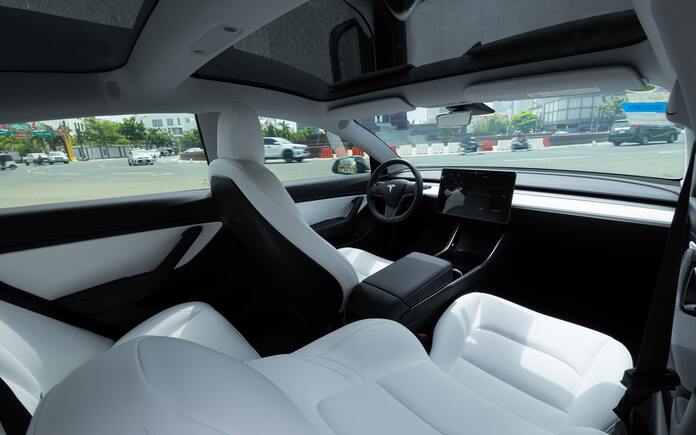Tesla, Inc. (NASDAQ:TSLA)
The whole world of electric vehicles (“EVs”) listens when Tesla, Inc. (NASDAQ:TSLA) makes a statement. It’s easy to see why LFP wasn’t popular in the West until Tesla began using it in their vehicles. Although Tesla stock investors are the intended audience for the 2023 Investor Day event, the ramifications may extend farther afield than that. This article will discuss the potential effects of a low-cost Tesla model and the most significant danger this event presents to the EV market.
An Electric Vehicle Within Reach of Most Budgets
Of course, there’s no way to know exactly what Elon Musk has planned for Tesla in his newest version of the Master Plan. Nonetheless, we can count on Tesla to reveal its plans for an affordable electric vehicle.
During the 2020 Battery Day event, Elon Musk revealed the company’s ambitions to offer an electric vehicle for $25,000. He justified the low price point by noting that advancements in battery technology will enable Tesla to do so while still turning a profit. The business is increasingly manufacturing its 4680 battery cells, the most notable new feature of which is its “tabless” design.
Nevertheless, the corporation has found it more challenging than projected to scale up manufacturing of the new cell layout. After commencing production in late 2020, Tesla reported in February that it has manufactured one million 4680 cells. The equivalent of approximately a thousand automobiles, to give you some perspective.
This has caused the business to postpone the buildout of its Gigafactory in Berlin, where they planned to produce 4,680 cells. If problems persist, why do so many anticipate that Tesla will soon launch its affordable electric vehicle (EV) model?
In December last year, Tesla boasted that it had manufactured 868,000 of its 4680 cells in only one week. This would suggest that the corporation has overcome many obstacles holding up mass production and can now shift its attention to expanding its 4680 cell manufacturing facilities.
This is consistent with what Andrew Baglino said about the 4680 cell production ramp at the most recent earnings conference. Before starting production of the Cybertruck in 2024, Tesla plans to work on a “cost-effective” ramp of the batteries at Giga Texas.
Our 4680 team’s fundamental 2023 objective is to beat Cybertruck to market with a cost-effective ramp of 4680s. Maximizing manufacturing process yields and fine-tuning the quality of the high-volume supply of mechanical components are two primary areas of attention. If we can pull off even half of those feats, we will have laid the groundwork for a significant 4680 years in 2024.
Moreover, Tesla promised in January to put $3.6 billion more into its Nevada Gigafactory, which would include two separate buildings. One of them will be used to produce Tesla Semis, but what piques our attention is the company’s intention to add 100 GWh of capacity to its 4680 production operations.
Elon Musk addressed this issue at the company’s fourth-quarter results call, saying:
Indeed, not all 100 GWh will power Semi trucks. As an example, I mentioned a few potential future offerings. The 4680 will be used in some upcoming items.
During the Nevada Gigafactory event, Musk said that Tesla would put its 4680 batteries to work in its stationary storage products. While this may be of little consequence, incorporating 4680 batteries into storage devices suggests that the manufacturer intends to manufacture the cells with LFP cathodes.
While I go into more detail about the chemistry involved here, LFP cathodes give up some range (because of the space premium) for lower prices and more excellent stability. LFP is the best option for lithium-based energy storage since this space premium is negligible in stationary storage.
Elon Musk, Tesla’s CEO, said the business plans to switch to iron-based chemistries for all of its energy storage systems in the Q4 2021 earnings call. As a result, including the 4680 cells in Tesla’s energy storage devices indicates the presence of an LFP 4680.
During the fiscal third quarter of the 2022 conference call, Musk finally addressed the company’s third-generation car platform. Musk responded to a question regarding the potential cost savings for the new car platform by saying that Tesla aims for a 50% decrease from the Model 3/Y platform.
Now that we have this information, let’s try some interpretations. Using LFP is a must for a cheaper car, but it won’t be enough to cut costs in half by itself.
However, more significant savings may be expected when LFP combines the company’s 4680 battery design and structural battery pack. This was established by the company’s statements on its stationary storage goods.
The timing of this event complements the company’s other recent announcements rather well. It seems that Tesla has resolved most of the problems associated with the 4680 design. The company’s planned 100 GWh expansion at the Nevada Gigafactory would be enough to provide the cells for a new high-volume car. However, unveiling a new vehicle would mesh well with Tesla’s expansion goals, with the Tesla Semi already in low-volume production and the Cybertruck entering low-volume production this summer.
In light of everything we’ve learned so far, the timing of this event makes the arrival of a cheap EV seem plausible. A $25,000 EV would be Tesla’s first really inexpensive EV. Still, given the company’s current supply chain issues and overall inflationary pressures, I wonder if it’s possible. The first production is anticipated to begin in 2025 or 2026.
Need To Deliver
There’s no denying that, in recent years, Tesla has become a hype machine. Although this is great for the firm in the long run, driving share prices to previously unseen heights, it also means that investors will look for a lot out of the company’s following announcements. Similarly, this happening is not an exception.
The already sky-high expectations have been further ratcheted up due to the widespread belief I and many others shared that Tesla would announce the inexpensive Model 3 at this event. Analysts would welcome a cheaper Tesla model in light of the ongoing recessionary fears and the high raw materials prices that are increasing the cost of batteries. This couldn’t have come at a better time.
Shares are expected to drop if Tesla doesn’t announce its inexpensive electric vehicle during the event, which has generated a lot of speculation and anticipation from investors. Shares will likely drop much more if Musk reaffirms his previous comments that the car would not be offered for sale with a steering wheel. It’s still being determined that the business will succeed.
However, if the new car is announced at the event and includes a steering wheel, the brand’s long-term growth potential would be significantly impacted. Although Tesla isn’t the only brand associated with electric cars, it’s likely the one that comes to mind first. Particularly true for the younger generation.
The typical Tesla buyer is 54 years old, however. Customers older than the demographic that typically buys Teslas are common. This is typical for expensive companies. Yet, it is precisely the issue.
Long-term, Tesla isn’t aiming to be a premium automaker. The company’s primary objective is to make electrification accessible to as many automobile consumers as possible. Yet, it will continue manufacturing premium cars and keeping that distinctive vibe. That goal will only be achievable if the world’s wealthiest people can afford automobiles.
By making its electric vehicles more affordable, Tesla can leverage its strong brand recognition and reach a more significant portion of its core customer base. The Tesla will likely become the most popular option for electric vehicles, even among people who aren’t already huge admirers. If you can afford a Tesla for the same price as a Chevrolet Bolt, why buy the former?
Potential Effect on the Market
The potential effect on Tesla’s stock price is an intriguing angle. Still, the effect on Tesla’s rivals might be much more significant. Tesla will not be able to sell 20 million EVs annually by 2030, which is the company’s stated target. Still, the firm has plenty of potential to expand.
As good as it is for Tesla, it’s terrible for almost every other automaker. The market for electric vehicles is often studied independently from the overall auto industry. Yet, that’s not the case.
Despite its obviousness, many individuals need to remember that EVs won’t increase the size of the car market. The market is becoming more saturated. That’s particularly the case if a new automaker like Tesla, which will account for less than 2% of the global auto industry in 2022 (based on sales projections), aims to capture 25% of the market in the following seven years.
Again, I really wonder if they will succeed. Yet if a really inexpensive car is introduced, it may be able to surpass 10 million, which would be bad news for the auto industry. Yet, tiny EV growth firms like Lucid Group, Inc. and Rivian Automotive, Inc. are the most vulnerable.
Let’s circle back to the idea that the EV market is just a subset of the more significant automotive industry. Having an electric vehicle is a selling factor right now. This is a specialized market.
Yet, as more and more established manufacturers electrify their product lines, EVs will be seen as no different from any other car. An electric motor option will soon join the EcoBoost engine option from Ford Motor Company. As EVs are simply automobiles, their market will eventually reach its capacity.
Until at least 2026, if not later, neither Lucid nor Rivian will offer a viable alternative to the Model 3 or the Model Y. By then, Tesla will have shifted its focus to an even cheaper car platform. The Chevrolet Bolt and Nissan Leaf won’t be the only affordable electric vehicles offered by established automakers in the future. I don’t see how either firm can survive in such a crowded market, especially given the lack of any raw materials sourcing plan.
For a long time, I battled against this line of thinking when it was used to discredit Tesla. With a significant first-mover advantage, Tesla was the inventor in the field. Yet, neither Lucid nor Rivian will rank in the top 15. That’s why they can’t come close to competing with Tesla regarding consumer recognition.
It creates issues when offering automobiles with identical features at a lower price. It may have been feasible had they been introduced to the market five years sooner. Yet Tesla’s low-cost electric vehicle shows how difficult their road will be. This could be devastating information for both parties.
While it is not certain that Tesla will reveal the car at this event, it will be shown soon. No matter the conclusion, investors in Lucid and Rivian should remember that Tesla is probably shooting for 2025 or 2026 as the year of production.
Automakers with a Long History
However, although this car might prove deadly for Lucid and Rivian, or at least enslave them to the luxury category in perpetuity, it will also affect the EV aspirations of conventional manufacturers. Particularly notable is GM.
GM hasn’t been shy about its ambitions regarding electric vehicle sales: it hopes to overtake Tesla within the decade. Yet, as I alluded to earlier, the Chevrolet Bolt, the company’s vehicle aimed at the mass market, may need help competing with a product from Tesla. That could be better for a corporation expecting EV sales to account for half its revenue growth by 2030.
General Motors will undoubtedly release new vehicles at competitive prices. The company’s Ultium battery architecture could help it achieve vast economies of scale. Still, GM is also now in second place behind Tesla. Regarding battery technology, Tesla has let chiefly its rivals catch up. Still, the scaling of 4680 cells is a worrying indication for those companies. With the impending release of the LFP model, Tesla may be able to turbo the EV pricing battle and undercut current rivals.
Although other automakers also suffer from a more reasonably priced Tesla, General Motors likely stands to lose the most, given the amount riding on the success of this EV transition in the medium to long term. Investors, particularly those invested in General Motors, should proceed cautiously until we see how the market reacts to this news. Even while GM is still my go-to for electric vehicles, I anticipate some hiccups in the wake of this.
Lesson for Investors
As a result of this occurrence, the industry as a whole will be affected. What is revealed here may foretell the trajectory of the electric car industry. Thus the stakes are high. This may be dictating the destiny of many different businesses.
Because of Tesla, Inc.’s dominance in the electric vehicle (EV) industry, this incident will likely affect investors speculating on the EV boom without EV makers. Several lithium manufacturers, for instance, dropped by more than 5% when news of CATL’s new pricing strategy was disclosed. But this has nothing to do with the decline in EV demand.
While the market reacted swiftly to the CATL announcement, a similar reaction would likely occur if Tesla disclosed cheaper batteries. The market would respond positively if the business announced intentions to buy Sigma Lithium Company. You should prepare for a rough journey since that’s all we can guarantee.
Featured Image: Pexels @ SCREEN POST









